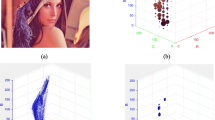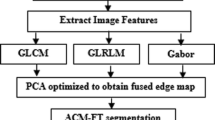Abstract
Purpose
Brain tumor segmentation is a required step before any radiation treatment or surgery. When performed manually, segmentation is time consuming and prone to human errors. Therefore, there have been significant efforts to automate the process. But, automatic tumor segmentation from MRI data is a particularly challenging task. Tumors have a large diversity in shape and appearance with intensities overlapping the normal brain tissues. In addition, an expanding tumor can also deflect and deform nearby tissue. In our work, we propose an automatic brain tumor segmentation method that addresses these last two difficult problems.
Methods
We use the available MRI modalities (T1, T1c, T2) and their texture characteristics to construct a multidimensional feature set. Then, we extract clusters which provide a compact representation of the essential information in these features. The main idea in this work is to incorporate these clustered features into the 3D variational segmentation framework. In contrast to previous variational approaches, we propose a segmentation method that evolves the contour in a supervised fashion. The segmentation boundary is driven by the learned region statistics in the cluster space. We incorporate prior knowledge about the normal brain tissue appearance during the estimation of these region statistics. In particular, we use a Dirichlet prior that discourages the clusters from the normal brain region to be in the tumor region. This leads to a better disambiguation of the tumor from brain tissue.
Results
We evaluated the performance of our automatic segmentation method on 15 real MRI scans of brain tumor patients, with tumors that are inhomogeneous in appearance, small in size and in proximity to the major structures in the brain. Validation with the expert segmentation labels yielded encouraging results: Jaccard (58%), Precision (81%), Recall (67%), Hausdorff distance (24 mm).
Conclusions
Using priors on the brain/tumor appearance, our proposed automatic 3D variational segmentation method was able to better disambiguate the tumor from the surrounding tissue.
Similar content being viewed by others
References
Archip N, Jolesz F, Warfield S (2007) A validation framework for brain tumor segmentation. Acad Radiol 14(10): 1242–1251
Batista J, Kitney R (1995) Extraction of tumors from MR images of the brain by texture and clustering. In: Proceedings of the 8th international conference on image analysis and processing (ICIAP ’95). Springer, London, pp 235–240
Capelle AS, Alata O, Fernandez-Maloigne C, Ferrié JC (2000) Unsupervised segmentation for automatic detection of brain tumors in MRI. In: IEEE international conference on image processing, ICIP 2000, Vancouver, Canada
Chan T, Vese L (2001) Active contours without edges. IEEE Trans Image Process 10(2): 266–277
Chan T, Sandberg B, Vese L (2000) Active contours without edges for vector-valued images. J Vis Commun Image Represent 11(2): 130–141
Cobzas D, Birkbeck N, Schmidt M, Jagersand M, Murtha A (2007) 3d variational brain tumor segmentation using a high dimensional feature set. In: IEEE 11th international conference on computer vision, pp 1–8
Corso J, Sharon E, Dube S, El-Saden S, Sinha U, Yuille A (2008) Efficient multilevel brain tumor segmentation with integrated Bayesian model classification. IEEE Trans Med Imaging 27(5): 629–640
Cremers D, Rousson M, Deriche R (2007) A review of statistical approaches to level set segmentation: integrating color, texture, motion and shape. Int J Comput Vis 72(2): 195–215
Droske M, Bernhard M, Martin R, Carlo S (2001) An adaptive level set method for medical image segmentation. In: IPMI ’01: Proceedings of the 17th international conference on information processing in medical imaging, Springer, London, pp 416–422
Fletcher-Heath L, Hall L, Goldgof D, Murtagh F (2001) Automatic segmentation of non-enhancing brain tumors in magnetic resonance images. Artif Intell Med 21(1-3): 43–63
Gibbs P, Buckley D, Blackb S, Horsman A (1996) Tumour volume determination from MR images by morphological segmentation. Phys Med Biol 41: 2437–2446
Kaus M, Warfield S, Nabavi A, Black P, Jolesz F, Kikinis R (1999) Adaptive template moderated brain tumor segmentation in MRI. Bildverarbeitung fur die Medizin. Springer, Berlin, pp 102–106
Kaus M, Warfield S, Nabavi A, Simon K, Chatzidakis E, Black P, Jolesz F, Kikinis R (1999) Segmentation of meningiomas and low grade gliomas in MRI. In: MICCAI ’99: Proceedings of the second international conference on medical image computing and computer-assisted intervention, Springer, London, pp 1–10
Khotanlou H, Atif J, Colliot O, Bloch I (2006) 3D brain tumor segmentation using fuzzy classification and deformable models. Fuzzy logic and applications. Springer, New York, pp 312–318
Koller D, Friedman N (2005) Structured probabilistic models, (unpublished manuscript)
Lee C, Greiner R, Schmidt M (2005) Support vector random fields for spatial classification. Lect Notes Comput Sci 3721: 121
Lee C, Greiner R, Zaiane O (2006) Efficient spatial classification using decoupled conditional random fields. Lect Notes Comput Sci 4213: 272
Liu J, Chelberg D, Smith C, Chebrolu H (2007) Distribution-based level set segmentation for medical images. In: 18th British machine vision conference (BMVC’07). Warwick, UK, 10–13 Sept, 2007
Macqueen JB (1967) Some methods of classification and analysis of multivariate observations. In: Proceedings of the fifth Berkeley symposium on mathematics, statistics and probability, pp 281–297
Malik J, Belongie S, Leung T, Shi J (2001) Contour and texture analysis for image segmentation. IJCV 43(1): 29–44
Mazzara G, Velthuizen R, Pearlman J, Greenberg H, Wagner H (2004) Brain tumor target volume determination for radiation treatment planning through automated MRI segmentation. Int J Radiat Oncol Biol Phys 59(1): 300–312
Popuri K, Cobzas D, Jagersand M, Shah S, Murtha A (2009) 3D variational brain tumor segmentation on a clustered feature set. In: Society of photo-optical instrumentation Engineers (SPIE) conference series
Prastawa M, Bullitt E, Moon N, Leemput K, Gerig G (2003) Automatic brain tumor segmentation by subject specific modification of atlas priors. Acad Radiol 10(12): 1341–1348
Roth S, Black M (2005) Fields of experts: a framework for learning image priors. In: IEEE computer society conference on computer vision and pattern recognition, IEEE Computer Society, 1999, vol 2, p 860
Rousson M, Deriche R (2002) A variational framework for active and adaptative segmentation of vector valued images. In: IEEE workshop on motion and video comp, pp 56–61
Rousson M, Brox T, Deriche R (2003) Active unsupervised texture segmentation on a diffusion based feature space. In: Computer vision and pattern recognition, 2003. Proceedings. 2003 IEEE computer society conference on, vol 2, pp 699–704
Schmidt M, Levner I, Greiner R, Murtha A, Bistritz A (2005) Segmenting brain tumors using alignment-based features. In: Proceedings fourth international conference on machine learning and applications, 2005. pp 215–220
Sean H, Elizabeth B, Guido G (2002) Level set evolution with region competition: automatic 3-d segmentation of brain tumors. In: Proceedings of the 16th international conference on pattern recognition. IEEE Computer Society, pp 532–535
Shi J, Malik J (2000) Normalized cuts and image segmentation. IEEE Trans Pattern Anal Mach Intell 22: 888–905
Sled JG, Zijdenbos AP, Evans AC (1998) A nonparametric method for automatic correction of intensity nonuniformity in mri data. IEEE Trans Med Imaging 17(1): 87–97
Smith S, Brady J (1997) Susan a new approach to low level image processing. Int J Comput Vision 23(1): 45–78
Vaidyanathan M, Clarke L, Velthuizen R, Phuphanich S, Bensaid A, Hall L, Bezdek J, Greenberg H, Trotti A, Silbiger M (1995) Comparison of supervised MRI segmentation methods for tumor volume determination during therapy. Magn Reson Imaging 13(5): 719–728
Varma M, Zisserman A (2005) A statistical approach to texture classification from single images. Int J Comput Vis V62(1): 61–81
Velthuizen R (1995) Validity guided clustering for brain tumor segmentation [treatment planning]. In: IEEE 17th annual conference engineering in medicine and biology society, 1995, vol 1, pp 413–414
Vinitski S, Gonzalez C, Knobler R, Andrews D, Iwanaga T, Curtis M (1999) Fast tissue segmentation based on a 4D feature map in characterization of intracranial lesions. J Magn Reson Imaging 9(6): 768–776
Xie K, Yang J, Zhang Z, Zhu Y (2005) Semi-automated brain tumor and edema segmentation using MRI. Eur J Radiol 56(1): 12–19
Yazdan-Shahmorad A, Jahanian H, Patel S, Soltanian-Zadeh H (2007) Automatic brain tumor segmentation using tissue diffisivity characteristics. In: ISBI 2007 4th IEEE international symposium on biomedical imaging from nano to macro, 2007, pp 780–783
Zhang J, Ma K, Er M, Chong V (2004) Tumor segmentation from magnetic resonance imaging by learning via one-class support vector machine. In: International workshop on advanced image technology, pp 207–211
Zuiderveld K (1994) Contrast limited adaptive histogram equalization. In: Graphics gems IV, Academic Press, Waltham, pp 474–485
Author information
Authors and Affiliations
Corresponding author
Rights and permissions
About this article
Cite this article
Popuri, K., Cobzas, D., Murtha, A. et al. 3D variational brain tumor segmentation using Dirichlet priors on a clustered feature set. Int J CARS 7, 493–506 (2012). https://doi.org/10.1007/s11548-011-0649-2
Received:
Accepted:
Published:
Issue Date:
DOI: https://doi.org/10.1007/s11548-011-0649-2




